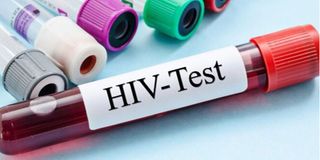Concern over rising HIV cases among Tororo married couples

According to the report, 1.4 million people are living with HIV in Uganda, while 1.3 million are on treatment. The the prevalence is higher among young women.
What you need to know:
- According to the report released by the Uganda Aids Commission (UAC) last year, 1.4 million people in Uganda are living with HIV, while 1.3 million are on treatment. The prevalence is higher among young women.
Health officials in Tororo District, eastern Uganda, have expressed concern over the rising HIV/Aids prevalence among married couples and teenagers.
Speaking during the belated World Aids Day celebrations organised by the district in Lyokango Town Board, Nyangole Sub-county, on Monday, the District Health Officer (DHO), Dr Okoth Obbo, blamed the rise on multiple sexual partners.
“Most of the married couples have multiple sexual partners and this has exposed many to contracting the disease,” he said, adding that the prevalence in the district stands at 4.8 percent.
Dr Obbo said it is time for religious, political and cultural leaders to double their efforts in fighting against HIV/Aids.
“This fight starts with the community knowing their status so as to achieve the 2030 target of 90 percent tested, 90 percent enrolled for care and treatment and 90 percent retained in care,” he said.
The DHO added that the tendency of young adolescents, especially the girls, to fear pregnancy more than acquiring HIV has worsened the situation in the long run.
“There is increased uptake of family planning services than the number of adolescents testing for HIV/Aids and it’s worse in rapidly growing centres that attract key populations,” he said.
According to the report released by the Uganda Aids Commission (UAC) last year, 1.4 million people in Uganda are living with HIV, while 1.3 million are on treatment. The prevalence is higher among young women.
The report further indicates that Busoga Sub-region has 3.3 percent, Teso (3.6 percent), Bukedi (3.2 percent), Elgon (2.9 percent), West Nile (2.4 percent), and Karamoja (1.2 percent), while Central or South Buganda leads with 8.6 percent, followed by Kampala and Acholi at 7.4 percent.
Other regions include Ankole (6.5 percent), Lango (6.4 percent), Central II or North Buganda (6.1 percent), Toro (5.2 percent), Kigezi (4.9 percent), and Bunyoro (4.5 percent).
Dr Obbo said there is also a need for more funding from the government, adding that the district relies on internal funding which stands at 85 percent compared to the local budget of 0.01 percent.
“The district should increase the allocation for HIV/Aids response to enable the directorate of health services in the district to reinforce existing intervention measures,” he said.
Mr Robert Wandwasi, the Mbale HIV/Aids officer, said anti-retroviral treatment (ART) retention reports in Mbale also indicate that 80.2 percent attended in the last six months, 66.5 percent in 12 months and 65.5 percent in 24 months.
“There is poor retention of clients on ART. They are not adhering to drugs yet this is risky to their health and others because we believe they are sexually active,” he said.
Mr Wandwasi added that they are losing about 5 percent of those enrolled on ARVs on a monthly basis, something he said is failing their efforts to facilitate scaling up of antiretroviral therapy to fight the disease.
Mbale has a HIV prevalence of 4.3 percent and a positivity rate at 3.8 percent, with more than 10,000 HIV patients currently enrolled on ART.
The Tororo deputy RDC, Mr Albert Amula, said moral decay is the major driving factor in the spread of HIV/Aids.
“The bad behaviour and failure to accept guidance and counselling from health workers have increased HIV prevalence among married couples and young adolescents,” he said.
Mr Amula appealed to the married couples to remain faithful to their partners to reduce the prevalence and also discouraged the community members from the practice of widow inheritance.
Ms Peace Asimire Tumwine, a programmes officer for Uganda Network of HIV/Aids Services Organisation, said there is need for increased funding for HIV/Aids activities in the district.




